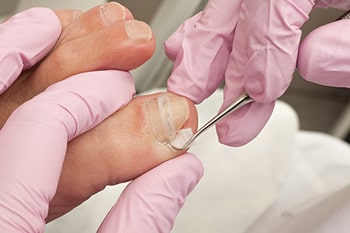
15 Oct What are Ingrown Toenails?
An ingrown toenail occurs when the side or corner of a toenail grows into the soft flesh of the toe. This condition, medically known as onychocryptosis, most often affects the big toe. When a nail breaks the skin, it can lead to discomfort and may introduce bacteria, potentially causing an infection. Understanding the causes, symptoms, and treatment options for ingrown toenails can help you manage this common foot problem effectively.
What Causes Ingrown Toenails?
Ingrown toenails can be quite painful, and understanding what causes them is key to both prevention and effective management. Many different factors can lead to a toenail growing into the surrounding skin. Let’s break down the most common culprits so you can identify potential risks.
- Improper Nail Trimming: One of the most frequent causes is cutting your toenails incorrectly. If you trim them too short or round the corners, the nail is more likely to grow into the soft skin of your toe. Always aim to cut your toenails straight across.
- Tight or Ill-fitting Footwear: Shoes that are too narrow, too tight, or have a shallow toe box can put constant pressure on your toes. This pressure can force the nail to grow abnormally into the skin. Activities that involve repetitive pressure on your feet, such as running or ballet, can also contribute.
- Genetics and Nail Shape: For some, it’s simply a matter of genetics. If your toenails are naturally very curved or wider than usual, they may be more prone to becoming ingrown.
- Toe Trauma: A direct injury to your toe, like stubbing it, kicking something hard, or dropping a heavy object on it, can disrupt the nail’s growth and lead to an ingrown issue.
- Poor Foot Hygiene: When the skin around your nails becomes overly soft or unhealthy due to lack of proper foot care, it can make it easier for the nail to penetrate and cause an ingrown toenail.
Being aware of these factors empowers you to make informed choices about your foot care and footwear. Recognizing these potential causes is the first step towards keeping your feet healthy and comfortable.
How Can You Spot Early Symptoms?
Recognizing the early signs of ingrown toenails can help you address the issue before it worsens. The first symptom is typically pain and tenderness along the side of the nail. You might notice some redness and slight swelling in the affected area. The toe might feel sensitive to any pressure, especially from shoes or even the weight of a blanket.
As the condition progresses, the symptoms can become more pronounced. The swelling may increase, and the skin around the nail might start to grow over the nail edge. You may also see a small amount of pus or drainage if an infection begins to develop. The area could feel warm to the touch, and the pain may become more constant.
How Are Ingrown Toenails Treated?
At-Home Care for Mild Cases
For mild ingrown toenails, you can often find relief at home. Try soaking your foot in warm, soapy water for 15 to 20 minutes a few times a day. This can help reduce swelling and tenderness. After soaking, gently dry your foot and carefully place a small piece of clean cotton or dental floss under the edge of the ingrown nail. This helps the nail grow correctly, above the skin. Wearing open-toed shoes or sandals also gives your toes more space and reduces pressure.
Professional Treatment for Persistent or Severe Cases
If home remedies don’t help, or if you see any signs of infection, it’s best to seek professional treatment. A podiatrist can lift the nail from the skin and place a tiny splint underneath it to guide its growth. For more severe or recurring ingrown toenails, a minor surgical procedure might be needed. This could involve partially or entirely removing the nail to resolve the issue effectively.
Consult a Podiatrist
If your symptoms are severe, show signs of infection, or do not improve with home care, seeking professional medical advice is a good step. Individuals with certain health conditions, like diabetes or poor circulation, face a higher risk of complications and should see a podiatrist at the first sign of an ingrown toenail. A specialist can properly diagnose the condition and recommend the best course of action. If you are experiencing persistent toe pain or discomfort from a suspected ingrown toenail, scheduling an appointment with a podiatrist can provide a clear diagnosis and an effective treatment plan for your specific needs.
- The Benefits of Group Programs for Weight Loss
- Exploring the Efficacy of Tirzepatide in Weight Loss Programs
- Your Topics Multiple Stories: A Complete Guide to Creating, Organizing, and Sharing Multi-Story Content
- Effective Home Remedies for Hemorrhoid Treatment
- Signs You Need an Eye Exam Sooner Rather Than Later

No Comments